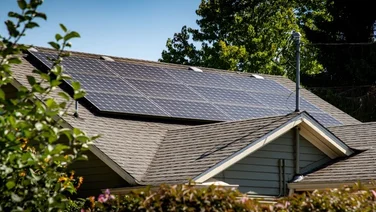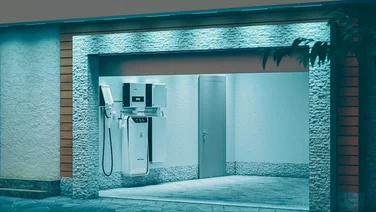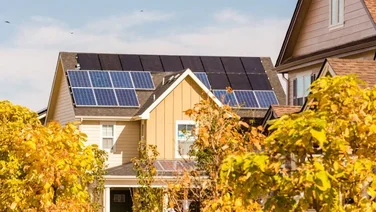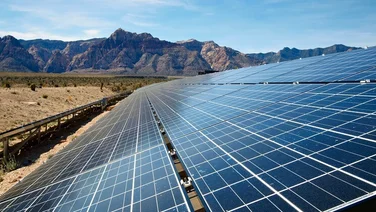✔ The number of panels will depend on your energy usage and local climate
✔ Homes in the Midwest will typically need more panels than the rest of the US
✔ The more efficient a panel is, the more electricity it’ll be able to generate
There are plenty of reasons to get solar panels in the US – they can lower your energy bills, reduce your carbon footprint, and can even be used to charge other green tech.
If you’re considering installing solar panels, you might have encountered one of the first obstacles that often leaves homeowners slightly bewildered – figuring out how many panels you need.
This is an important thing to figure out. If you install too many panels, you’ll be wasting money on unnecessary materials and installation time, while getting too few panels could make your purchase unprofitable.
And with America being as big as it is, the number of panels you’ll need varies from state to state.
Luckily, we’ve done the research for you.

What’s on this page?
How many solar panels do you need?
The average home in America – measuring roughly 1,500 square feet – will need between 15 and 18 solar panels on its roof.
However, the exact number of solar panels you’ll need will vary, depending on your average energy consumption, the property size, and the amount of sunshine in your local area.
And since Northern America is the third-largest continent, each state is exposed to drastically different amounts of sunshine, which means some will need more – or fewer – solar panels to provide the same amount of electricity.
Bottom line: every home is unique and will need a different number of solar panels.
We know this isn’t the answer you were hoping for when you came to this page. So, to give you a better idea of how many panels you’ll need to buy, we’ve outlined how many solar panels different types of homes need in the four main US regions.
Bear in mind that these are only averages, based on a solar panel output of 350 watts.
Northeast
Property size | Average electricity consumption per year (kWh) | Number of panels | Potential annual solar production (kWh) |
|---|---|---|---|
Small apartment (5> units) | 4,120 | 10 | 4,261 |
Large apartment (2-3 units) | 6,334 | 16 | 6,819 |
Attached home | 7,202 | 17 | 7,671 |
Detached home | 10,599 | 25 | 10,654 |
South
Property size | Average electricity consumption per year (kWh) | Number of panels | Potential annual solar production (kWh) |
|---|---|---|---|
Small apartment (5> units) | 5,536 | 10 | 5,909 |
Large apartment (2-3 units) | 6,143 | 11 | 6,500 |
Attached home | 8,402 | 15 | 8,864 |
Detached home | 10,754 | 19 | 11,228 |
Midwest
Property size | Average electricity consumption per year (kWh) | Number of panels | Potential annual solar production (kWh) |
|---|---|---|---|
Small apartment (5> units) | 8,652 | 19 | 8,833 |
Large apartment (2-3 units) | 8,919 | 20 | 9,298 |
Attached home | 11,063 | 25 | 11,623 |
Detached home | 15,819 | 35 | 16,272 |
West
Property size | Average electricity consumption per year (kWh) | Number of panels | Potential annual solar production (kWh) |
|---|---|---|---|
Small apartment (5> units) | 4,581 | 8 | 4,855 |
Large apartment (2-3 units) | 5,173 | 9 | 5,461 |
Attached home | 6,816 | 12 | 7,282 |
Detached home | 10,330 | 18 | 10,923 |

How to calculate how many solar panels you need
If you want a better idea of how many solar panels you’ll need to cover your electricity needs, you’ll need to consider three key factors:
- Your average daily energy consumption
- The amount of sunshine in your local area
- The size of your roof
1. Your average daily energy consumption
The first thing you need to do is work out how much electricity your household is consuming each year. This is usually stated on your energy bills and will be measured in kilowatt-hours (kWh).
If you don’t have an annual summary or the past 12 months’ bills, you just need to contact your supplier, who will let you know your yearly total.
If you want a rough idea of the number of panels you’ll need, you can compare your annual energy consumption to one of the tables above. Alternatively, move on to step two.
2. The amount of sunshine in your local area
Now that you have your annual electricity consumption, you’ll need to divide this figure by the solar panel’s wattage, which will give you the number of panels you’ll need – but we’re not done just yet.
This number then needs to be adjusted to account for the amount of sunshine your area is exposed to.
To find this out, you just need to visit the Renewable Resource Data Center.
It’s also worth contacting a local solar panel supplier for advice on how much the weather will impact your solar panel output.
3. The size of your roof
Once you’ve figured out roughly how many solar panels you’re going to need to power your property, it’s a matter of figuring out whether your roof can actually fit that many panels onto it.
A good starting point is to check your building plans or hire a professional to measure your roof.
If your roof is too small for the number of average solar panels you need, you can just consider high-efficiency panels instead.
Do the solar panel requirements vary from state to state?
Yes, the number of solar panels a property needs varies drastically from state to state. This is because some states have a lot more exposure to sunshine than others, which means they will need fewer panels to power their home.
If we compare some of the figures from the tables above, we can see just how much sunshine impacts solar panel output. For example, a detached home in the Midwest will need an average of 35 solar panels to power all of its electrical needs, compared to 25 in the Northeast, 19 in the South, and only 18 in the West.
This means a detached home in the Midwest could need almost double the amount of the same property on the West coast.
It’s also important to consider that US regions consume different amounts of energy. For example, the average detached property in the Midwest consumes 15,819 kWh of electricity per year, compared to just 10,330 kWh in the South.
Can solar panels cover 100% of your electricity needs?
It is possible for solar panels to completely cover your energy bills, but this is a significant financial investment – one that is simply unattainable for a lot of Americans.
This partly comes down to the sheer amount of energy the average American home gets through. For example, the US Energy Information Administration (EIA) states that in 2021, the average annual electricity consumption for a US residential utility customer was 10,632 kilowatt-hours (kWh). To compare, the typical domestic household in the UK consumes 3,100 kWh of electricity per year.
To cover this amount of electricity, homeowners need to install more solar panels, which means they have to fork out more for the upfront costs.
Summary
The number of solar panels a homeowner will need to install varies a lot depending on a few key factors, including their annual energy consumption, their location, and the size of their roof.
Whilst some properties in select areas of the US can cover their bills with solar panels, many will struggle to do so without investing a lot of money.
But whether you can install enough solar panels to cover all of your electricity needs, or enough to at least reduce the financial impact of your energy bills, they’re a worthwhile investment.




